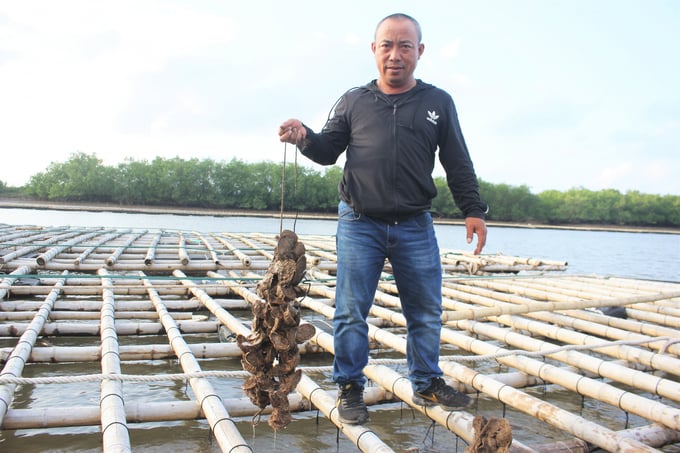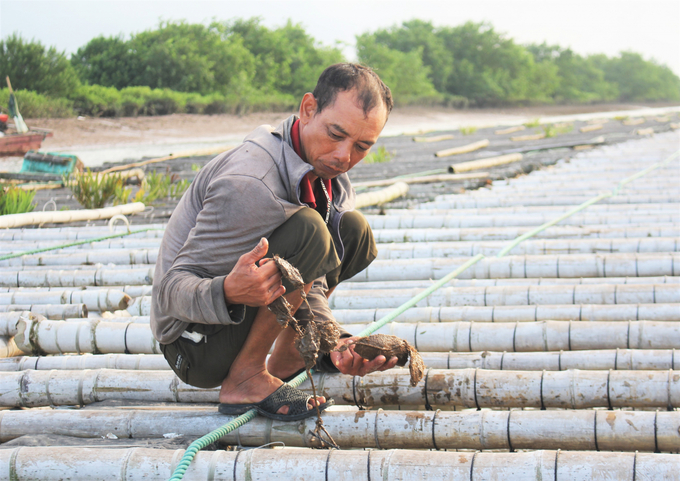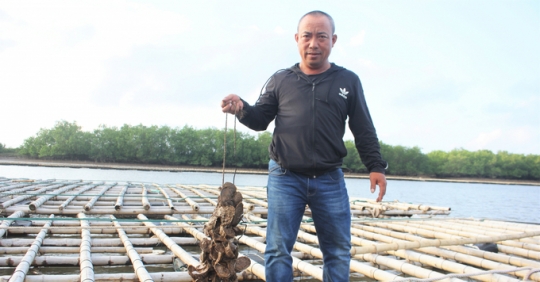
Mr. Ta Van Thiet, Nam Thanh Township, Tien Hai, Thai Binh, succeeded in cultivating hanging oysters in the Ba Lat estuary. Picture: Trung Quan.
Strolling along the mouth of Ba Lat, Nam Phu, Tien Hai and Thai Binh communes (where the Red River meets the sea), it is not difficult to see bamboo rafts being roped by people in Nam Phu, Nam Hung and Nam Thanh hang . lie close together, stretch.
According to many households here, although brackish water oyster farming is just beginning to develop in the area, it has opened a new direction for the development of effective and sustainable aquaculture. Contribute to helping people increase output, increase income, improve living standards and become wealthy.
Mr. Ta Van Thiet from Nam Thanh Township, who was the first to bring oysters to the farm in Ba Lat Estuary, shared: In 2018, he decided to change direction and develop brackish oyster farming in his hometown. He invited experts and experienced oyster farmers to Quang Ninh to study and evaluate water sources in the Ba Lat estuary. This makes the water here perfectly suitable for oyster farming.
After the local government received approval, the waterway management units built a raft to bring the first batch of oysters for sampling. After 6 months, when he saw that all the oysters farmed in the estuary were growing and developing healthily, he decided to make a big investment.
From the first few plots then increased to 200 rafts, until now, Mr. Thiet has received 500 rafts for level 1 oyster farming to provide seed for the focus in Quang Ninh to continue farming to sell oysters for meat (each raft ) In an area of about 80m2, it can grow 600 lines of oysters, each weighing 4-5kg).

Thai Binh people farm oysters hanging on the estuary, no cost of food, high survival rate, easy to handle, care and harvest. Picture: Trung Quan.
Mr. Thiet said: Oysters are easy to breed, require little maintenance, live mainly on algae and natural plankton, so there are no feed costs. Farmers only need to use quality seeds from reputable breeders.
Monitor and clean the raft regularly during the rearing process to limit snails, organisms and sludge that can cause oysters to die or slow down. However, to successfully farm oysters in estuaries, farmers must understand the seasonal behavior of oysters and regularly check the salinity of the water, otherwise oysters are susceptible to disease and death.
“In order for oysters to grow and develop healthily, water is very important in addition to high-quality seed. If the water is too salty or too sweet, the oysters will die. Oyster farming in the estuary has the advantage of a continuous flow of fresh and salt water, so the salinity of the water is kept stable at 10-20 PPT to support the growth of the oysters,” said Thiet.
According to Mr. Thiet, in addition to favorable factors, oyster farming in the estuary faces many risks such as natural disasters, storms, floods, drought, water pollution from upstream to consider the possibility of rafting deep into the river or out to sea if the Water salinity changes (the water salinity exceeds 25-30 PPT, the oysters die).
Therefore, the raft is floated on the water, tied with a rope to ensure the convenience of separating the raft for moving, and someone is regularly deployed 24/7 to take care of and monitor the salinity of the water. In addition, the initial investment costs are quite high on average to get an oyster raft up and running. The investment cost is about VND 6.5 million, while if you want to be profitable, you need to raise a large number of rafts.
Regarding profitability, Mr. Thiet shared that he sells oysters for VND 30,000/string on average. Thus, with each raft lifting 600 ropes, he earns 18 million dongs, after deducting expenses, he has a profit of 50%. He created jobs for 6 main workers with an income of 8-9 million VND/person and 20 seasonal workers.
Mr. Dang Van Binh, Nam Thanh township with 50 oyster rafts, said, “It is becoming increasingly difficult to catch seafood because natural resources are gradually being exhausted, the cost of gasoline, oil and labor is high.” Developing the water surface in the estuary Oyster farming in particular, and other aquatic products in general, will help lowland people improve their economic efficiency and feel secure in sticking to the river and sea.

